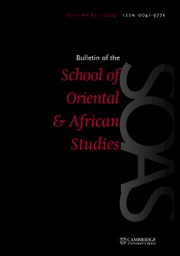The complete, critical translation of a major historical text is cause for celebration, particularly when the author is “arguably the most important Ottoman intellectual figure of the 11th/17th century”, as Hagen, foremost scholar of Kātib Çelebi (aka Ḥāccī Ḫalīfa), writes elsewhere. Hagen considers Cihānnümā – or Cosmorama – the first Ottoman work to give an authoritative, unified image of the world unconstrained by contemporary boundaries between genres. He deems it a radical departure from previous geographies, not least for its awareness that geographical knowledge is relevant for addressing the practical challenges facing the state. It is, as Robert Dankoff, Hagen's eminent co-editor opines, “a monster of a text”. The more praise to the translators.
Unlike many notable Ottoman figures, Kātib Çelebi's biography can be pieced together from his writings. He had a modest start, being apprenticed to the chancery before travelling widely on imperial campaigns as a clerk. That his career then stalled allowed him to pursue his chosen path of erudition. He came to consort on equal terms with prominent men of letters as an independent scholar and public intellectual, and as the prolific author of ground-breaking works. Hagen ventures that he may have had the largest private library in Istanbul. He died in his late forties.
Cihānnümā is the geographical component of Kātib Çelebi's “most enduring intellectual legacy”, his Encyclopaedic Project, a multi-volume set of books that aimed to make all accumulated knowledge available. Its writing was prompted by the outbreak of the Cretan War in 1645, when the empire faced serious troubles that demanded informed solutions.
Unusually in the study of manuscripts, the compilation of Cihānnümā can be documented from beginning to end. It began as an expansion of a late-sixteenth-century geographical dictionary that was itself an alphabetical treatment of a fourteenth-century work. Kātib Çelebi's additions were significant, but he abandoned this endeavour when he was unable to find sources for Christian Europe. Help came from a French convert in Istanbul who translated such works for him. Thus he was introduced to the Atlas Minor, derived from Mercator's original, that became the basis for the second, autograph version of Cihānnümā. Its geographical coverage begins with the east – Japan and China – and proceeds westwards.
Cihānnümā was well received, and the autograph of both versions, plus Katib Çelebi's other geographical works, came into the hands of a fellow intellectual, Vişnezāde Meḥmed 'İzzeti, who passed them on to another geographer in his circle, Ebū Bekr b. Behrām ed-Dimaşḳī. Ebu Bekr had produced a translation from Latin of Joan Blaeu's eleven-volume Atlas Maior, and intended to use the second autograph of Cihānnümā to supplement this work. There matters stood, until İbrāhīm Mütefferiḳa, famous for pioneering printing in Ottoman Turkish, published Cihānnümā in 1732. Müteferriḳa's text is a compilation of Kātib Çelebi's second autograph as annotated by Ebu Bekr, interpolations of his own, and, because the work ended with the province of Van, additional material that brought the description of the Ottoman realm as far west as the Bosphorus. Müteferriḳa's method was impeccable: he marked his and Ebū Bekr's notes and additions clearly. He informs us that he took the additional section of the work from a geographical text written by Ebu Bekr – but no known work of Ebū Bekr can with confidence be identified as this source. Müteferriḳa's Cihānnümā proved popular at home, but also among Europeans eager for knowledge about their neighbour.
In keeping with the demands of the times, Müteferriḳa's Cihānnümā included 45 pages of maps and diagrams, some of them derived from Kātib Çelebi's manuscripts. They are reproduced here with translations. Comparing the two versions of Cihānnümā shows how Kātib Çelebi's style evolved as he experimented, and how his understanding of mapping developed.
Hagen sees innovation also in the substantial explanation of the purpose and method of geography that prefaces Kātib Çelebi's descriptions of places, and in his interest in the culture and history of each place described. He presents his material according to a template of categories for each geographical entity, which brings to this reviewer's mind the method of his contemporary, Evliyā Çelebi. This template is partly adapted from the categories employed in the Atlas Minor, and citation of sources – a mixture of Islamic texts and other European works in addition to the Atlas Minor – authenticates the Cihānnümā.
Until now, readers have typically had to rely on Müteferriḳa's text of Cihānnümā. This is not without errors, and is reminiscent of the reliance of a previous generation on the defective printed version of Evliyā Çelebi's Seyāḥatnāme, or Book of Travels, for the century before the transcription of the original volumes appeared. Happily, the scholars involved in making this critical edition could refer for clarification to Kātib Çelebi's second autograph. But Kātib Çelebi was himself confused about placenames, sometimes taking these from different European sources that spelt them variously.
Evliyā Çelebi's Seyāḥatnāme is a compendium of knowledge about the world deriving from his own, therefore “up-to-date”, experiences, even if he embellishes his text with wit and exaggeration, and inevitably makes mistakes. Kātib Çelebi did not trust travellers’ accounts, and because Cihānnümā encompassed only the lands as far west as the Ottoman eastern borders when he died, did not have the opportunity to incorporate observations made on his journeys with the army. Cihānnümā is therefore based on the writings of others than its author, some of them hardly current, and cannot be considered the latest word. Given the chance, might he have included personal experience? We can only wonder.
By probing the Cihānnümā so skilfully, the scholars involved in producing this volume have amply demonstrated the significance of its author and revealed the caveats that must guide our reading of his text. Kātib Çelebi's foremost geographical work is now widely accessible in an exemplary edition, thanks to the considerable efforts of the expert team that undertook this ambitious work.



